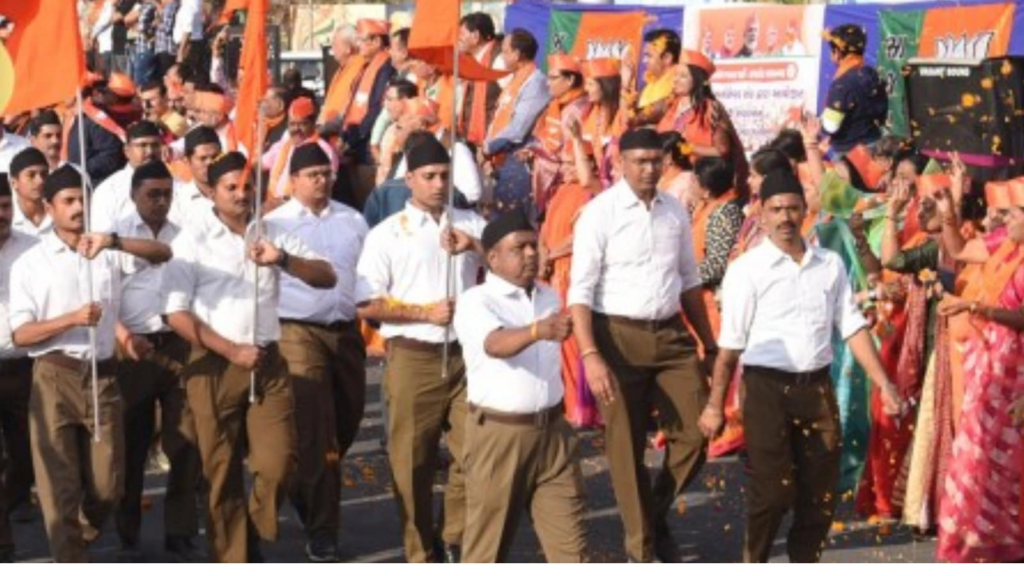With “sushasan aur vikas (good governance and development)” as its buzzwords, the RSS played a silent role in the NDA’s sweeping victory in the Bihar Assembly elections, especially in the Seemanchal region that has a sizable Muslim population, Sangh and BJP insiders said.
According to sources, at least 100 volunteers from the Sangh and affiliated organisations were deployed across each of Bihar’s 38 districts, while an estimated 5,000 activists of the Akhil Bharatiya Vidyarthi Parishad (ABVP), the RSS’s student wing, were divided into tolis or groups of five each to work silently round the clock in Bihar during peak campaigning.
Contributing to an enhanced vote share for the alliance compared to 2020, when some of the NDA members such as the then-undivided Lok Janshakti Party (now the LJP Ram Vilas) and the Rashtriya Lok Morcha contested the polls independently, the RSS threw its weight behind each of the ruling coalition’s constituents with a door-to-door outreach, insiders said.
RSS sources pointed to significant increments in the vote share of all NDA parties in the seat that each contested: the BJP’s from 42.56% in 2020 to 48.44% this time, the Janata Dal (United)’s 46.2% up from 32.83%, the LJP(RV) from 10.26% to 43.18%, the Hindustani Awam Morcha (Secular) climbing from 32.28% to 48.39%, and the RLM to 41.09% up from 4.41%.
With the NDA more than confident of reaching the Assembly’s halfway mark of 122 seats yet again, the Sangh’s aim, sources said, was to ensure that votes were cast based on “performance” or causes such as “nationalism or interests of the Hindu community” in a state historically known to follow caste-related considerations.
“While some volunteers were permanently based in Bihar, others, such as those from the ABVP and studying at academic institutions across the country, participated in the outreach during whatever time they could spare, especially during the 10 to 15-day period preceding the first phase of polling,” an RSS leader said.
“Unlike the campaign undertaken by the parties and their respective leaders, something that the Sangh and its affiliates do not engage in, the Sangh’s campaign was based on underlining that caste considerations were myopic when exercising their franchise in seats that the NDA parties identified as somewhat of a challenge,” the source added.
RSS, Minority Morcha in Seemanchal
RSS insiders said when it came to constituencies with “discernible changes in demography over the recent past”, the Sangh relied on its support base built over decades. In the Seemanchal region, for example, where the Sangh has built its presence in the last 10 to 15 years through social service and volunteer work, it was able to play “a significant role in consolidating the Hindu vote over and above caste lines in as many as 28 to 32 seats there”.
 2025 results in 32 seats with large Muslim populations
2025 results in 32 seats with large Muslim populations
“If the number of votes polled in favour of NDA candidates has increased, leading to increments in vote share for parties on the whole, it means that voters from across caste and community divides have preferred the cause – whether it is sushasan and vikas, or larger ones such as nationalism and the interests of the Hindu community – over narrower caste considerations while voting,” said a source who was part of the Sangh outreach.
Sources in the BJP said a similar campaign undertaken by its own national Minority Morcha, which started with a targeted door-to-door outreach focused on Muslim households in July, plugged whatever gaps remained.
The NDA fielded only five Muslim candidates across the 243 seats in the state. While the BJP did not give a single ticket to Muslims, the JD(U) fielded four and the LJP(RV) one.
Detailed election results show that the NDA registered victories in 21 of the 32 seats where Muslim voters outnumber those from other communities, with the BJP winning 10, the JD(U) eight, the LJP (RV) two, and the RLM one.
These seats are Madhubani, Bisfi, Sheohar, Harlakhi, Benipatti, Khajauli, Babubarhi, Keoti, Narpatganj, Jale, Araria, Jokihat, Sikti, Bahadurganj, Thakurganj, Kishanganj, Kochadhaman, Raniganj, Forbesganj, Katihar, Kadwa, Balrampur, Pranpur, Manihari, Barari, Kasba, Banmankhi, Rupauli, Dhamdaha, Purnia, Amour, and Baisi.
The NDA had led in these seats in 2020 too, with 18 wins against the Mahagathbandhan’s nine. The BJP had won 12 seats and the JD(U) six.
BJP Minority Morcha president Jamal Siddiqui said its campaign focused on the “positive impact” of Central welfare schemes, adding that people’s faith in the “tikau (durable)” government of Nitish Kumar, coupled with the NDA’s emphasis on Prime Minister Narendra Modi’s “politics of development”, helped the NDA coast to victory.
“This means that Muslim voters have decided to get associated with the politics of development. We communicated how Central schemes such as Ujjwala and Awas yojanas, and direct benefit transfers were for everyone irrespective of their religion,” Siddiqui said.
BJP national Minority Morcha vice president S M Akram said the NDA’s relative success in seats falling under the Kishanganj Lok Sabha segment, which has six Assembly seats divided across the Kishanganj and Purnia districts, was a particular case in point.
In several of the seats with large Muslim populations, the NDA was not only able to retain seats by polling more votes — such as in Banmankhi, Purnia, Katihar, and Pranpur — it also wrested seats won by the Opposition Mahagathbandhan in 2020, including Sheohar (JD-U took it from the RJD); Thakurganj (JD-U wrested it from the RJD); and Kadwa (JD-U wrested control from the Congress).

